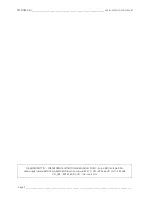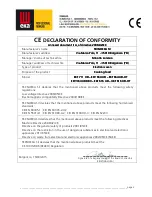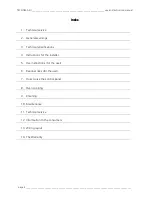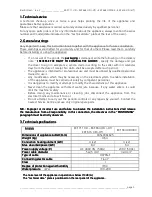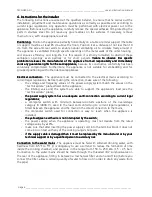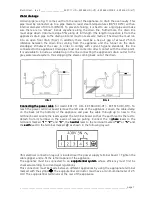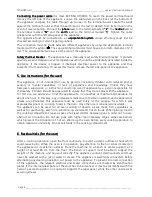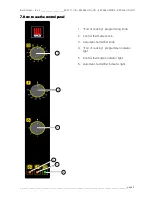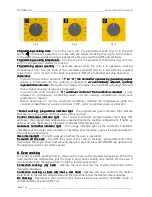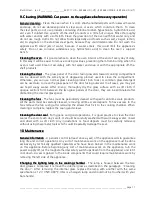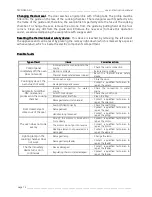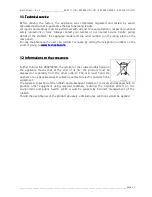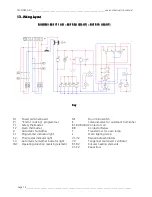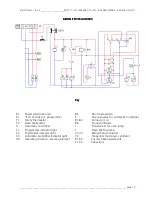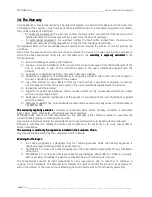
TECNOEKA Srl ______________________________________________________________ use and instruction manual
page 8 __________________________________________________________________________________________
Connecting th
Connecting th
Connecting th
Connecting the power cable
e power cable
e power cable
e power cable (for mod. EKF 664 UD/003)- To reach the power terminal board
remove the left side of the appliance. Loosen the cable-clamp on the back (at the bottom) of
the appliance and pass the cable through up to near to the terminal board. Locate the leads
against the terminal board so that the earth lead is the last to detach from its terminal in the
event of reverse pulling. Connect the phase
phase
phase
phase lead to the terminal marked “
“
“
“L”
L”
L”
L”, the neutral
neutral
neutral
neutral lead to
the terminal marked “N”
“N”
“N”
“N” and the earth
earth
earth
earth lead to the terminal marked
. Tighten the cable
gripper and re-fit the left side-panel of the appliance.
The appliance must be connected to an equipotential system
equipotential system
equipotential system
equipotential system whose efficiency must first be
checked according to current legal regulations.
This connection must be made between different appliances by using the appropriate terminal
marked with the symbol . The equipotential conductor must have a minimum diameter of 2,5
mm
2
The equipotential terminal is at the rear of the appliance.
Safety ther
Safety ther
Safety ther
Safety thermal breaker
mal breaker
mal breaker
mal breaker - The appliance has a manually reset safety thermal breaker. It protects
against excessive dangerous over-temperatures which could be accidentally generated inside the
appliance. If the device is tripped, it interrupts electrical power to the appliance and thus
prevents it from operating. To access this device, remove the left side-panel of the appliance.
5.
5.
5.
5. Use instructions (for the user)
Use instructions (for the user)
Use instructions (for the user)
Use instructions (for the user)
This appliance is not intended for use by persons (including children) with reduced phycal,
sensory or mental capabilities, or lack of experience and knowledge. Unless they have
beengiven supervision or instruction concerning use of appliance by a person responsible for
their safety. Children should be supervised to ensure that they do not play with the appliance.
For first use, we advise you to let the appliance to run load-free at maximum temperature for
about one hour. In this way, any unpleasant smells due to thermal insulation and residual work
grease are eliminated. This appliance must be used solely for the purpose for which it was
expressly designed, i.e. cooking foods in the oven. Any other use is considered unsuitable.
The appliance can be used: for all oven cooking of deserts, pizzas, meat, fish, vegetables, as
well as for gratinating, and for re-conditioning cooled and frozen foods. When placing food in
the cooking compartment, leave a space of at least 40 mm between pans in order not to over-
obstruct air circulation. Do not use pans with higher than necessary edges: edges are barriers
which prevent the circulation of hot air. Warm up the oven before every cooking operation to
obtain maximum uniformity. Do not salt foods in the cooking compartment.
6.
6.
6.
6. Residual risks (for the user)
Residual risks (for the user)
Residual risks (for the user)
Residual risks (for the user)
After a cooking operation, open the door cautiously, to avoid a violent outflow of heat which
could cause burns. While the oven is in operation, pay attention to the hot zones (marked on
the appliance) of its external surfaces. Place the machine on a bench or similar support, at a
height of at least 85 cm from the floor. The bench or support must be able to support the
weight of the machine and house it correctly. The appliance contains electrical parts and must
never be washed with a jet of water or steam. The appliance is electrically connected: before
attempting any cleaning operation, cut power to the appliance. To prevent incorrect connection
of the appliance, the relevant electrical and water connections are marked by identification
plates. If the internal glass panel of the door has to be cleaned, it must be dismantled with the
help of a second operator: one operator supports the glass panel, while the other unscrews its
securing screws.


